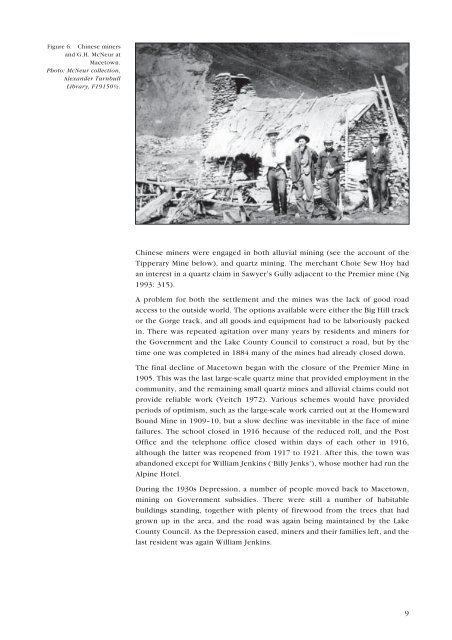Archaeological survey of the Arrow River and Macetown, Otago ...
Archaeological survey of the Arrow River and Macetown, Otago ...
Archaeological survey of the Arrow River and Macetown, Otago ...
You also want an ePaper? Increase the reach of your titles
YUMPU automatically turns print PDFs into web optimized ePapers that Google loves.
Figure 6. Chinese miners<br />
<strong>and</strong> G.H. McNeur at<br />
<strong>Macetown</strong>.<br />
Photo: McNeur collection,<br />
Alex<strong>and</strong>er Turnbull<br />
Library, F19150½.<br />
Chinese miners were engaged in both alluvial mining (see <strong>the</strong> account <strong>of</strong> <strong>the</strong><br />
Tipperary Mine below), <strong>and</strong> quartz mining. The merchant Choie Sew Hoy had<br />
an interest in a quartz claim in Sawyer’s Gully adjacent to <strong>the</strong> Premier mine (Ng<br />
1993: 315).<br />
A problem for both <strong>the</strong> settlement <strong>and</strong> <strong>the</strong> mines was <strong>the</strong> lack <strong>of</strong> good road<br />
access to <strong>the</strong> outside world. The options available were ei<strong>the</strong>r <strong>the</strong> Big Hill track<br />
or <strong>the</strong> Gorge track, <strong>and</strong> all goods <strong>and</strong> equipment had to be laboriously packed<br />
in. There was repeated agitation over many years by residents <strong>and</strong> miners for<br />
<strong>the</strong> Government <strong>and</strong> <strong>the</strong> Lake County Council to construct a road, but by <strong>the</strong><br />
time one was completed in 1884 many <strong>of</strong> <strong>the</strong> mines had already closed down.<br />
The final decline <strong>of</strong> <strong>Macetown</strong> began with <strong>the</strong> closure <strong>of</strong> <strong>the</strong> Premier Mine in<br />
1905. This was <strong>the</strong> last large-scale quartz mine that provided employment in <strong>the</strong><br />
community, <strong>and</strong> <strong>the</strong> remaining small quartz mines <strong>and</strong> alluvial claims could not<br />
provide reliable work (Veitch 1972). Various schemes would have provided<br />
periods <strong>of</strong> optimism, such as <strong>the</strong> large-scale work carried out at <strong>the</strong> Homeward<br />
Bound Mine in 1909–10, but a slow decline was inevitable in <strong>the</strong> face <strong>of</strong> mine<br />
failures. The school closed in 1916 because <strong>of</strong> <strong>the</strong> reduced roll, <strong>and</strong> <strong>the</strong> Post<br />
Office <strong>and</strong> <strong>the</strong> telephone <strong>of</strong>fice closed within days <strong>of</strong> each o<strong>the</strong>r in 1916,<br />
although <strong>the</strong> latter was reopened from 1917 to 1921. After this, <strong>the</strong> town was<br />
ab<strong>and</strong>oned except for William Jenkins (‘Billy Jenks’), whose mo<strong>the</strong>r had run <strong>the</strong><br />
Alpine Hotel.<br />
During <strong>the</strong> 1930s Depression, a number <strong>of</strong> people moved back to <strong>Macetown</strong>,<br />
mining on Government subsidies. There were still a number <strong>of</strong> habitable<br />
buildings st<strong>and</strong>ing, toge<strong>the</strong>r with plenty <strong>of</strong> firewood from <strong>the</strong> trees that had<br />
grown up in <strong>the</strong> area, <strong>and</strong> <strong>the</strong> road was again being maintained by <strong>the</strong> Lake<br />
County Council. As <strong>the</strong> Depression eased, miners <strong>and</strong> <strong>the</strong>ir families left, <strong>and</strong> <strong>the</strong><br />
last resident was again William Jenkins.<br />
9
















